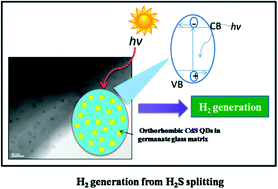It is renowned that the oil refineries are venting off 15–20% H2S and hardly 5% has been utilized to produce sulphur and water ubiquitously by the Claus process. This process is un-economical, highly polluting and by-products create further acute environmental problems. Here, we have demonstrated the significant approach of the conversion of poisonous H2S into H2 by stable orthorhombic QD–CdS–glass nanosystems using a most abundant solar light energy source. This is an eco-friendly process that produces cheaper hydrogen as well as degrades organic dyes efficiently. We have investigated a novel, Q-CdS (highly mono-dispersed) germanate glass nanocomposite. Surprisingly, the CdS quantum dots (QDs) obtained in the glass matrix are orthorhombic in structure and highly thermally stable. Generally, the orthorhombic CdS powder is in a metastable state i.e. unstable at normal conditions. The quantum dots of 4–14 nm size of CdS were grown for the first time in the germanate glass. The confinement of orthorhombic CdS was studied using UV-Vis spectroscopy and photoluminescence. There is a drastic change in the band gap of glass without CdS nanocrystals (3.16 eV) as compared to the glass with orthorhombic CdS QDs (2.25 eV). Considering the suitable band gap of the CdS quantum dot–glass for the visible light absorption, the studies of the photocatalytic activity for H2 generation and dye degradation was performed under visible light irradiation for the first time. High H2 evolution, i.e. 3780 μmol h−1, was obtained, which is much higher than earlier reported for CdS nano-powder. More significantly, the catalyst is stable and easily regenerated as compared to other normal catalysts. The glass nanocomposite also showed excellent methylene blue degradation under visible light irradiation. Such orthorhombic QD–CdS–glass nanocomposites have great significance because they have potential applications in solar cell, LED and other optoelectronic devices.

You have access to this article
 Please wait while we load your content...
Something went wrong. Try again?
Please wait while we load your content...
Something went wrong. Try again?


 Please wait while we load your content...
Please wait while we load your content...